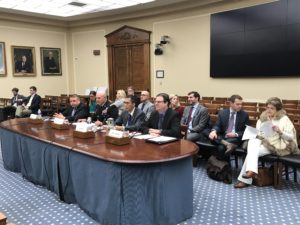
Code Council testifies before the House Science Committee
The Subcommittee on Research and Technology and the Subcommittee on Environment of the House Committee on Science, Space and Technology held a joint hearing titled “Calm Before the Storm: Reauthorizing the National Windstorm Impact Reduction Program” on Dec. 4, 2019, in Room 2318 of the Rayburn House Office Building in Washington, D.C. Ryan M. Colker, J.D., CAE, vice president of Innovation for the International Code Council and executive director of the Alliance for National and Community Resilience, testified at the hearing.

The purpose of the hearing was to review the activities of the National Windstorm Impact Reduction Program (NWIRP) which is up for reauthorization, explore how the program can support increased interdisciplinary research efforts, examine ways to improve transfer of research to the building code community and others to help mitigate damage caused by windstorms, and evaluate other priorities Congress should consider for the next reauthorization of this program. The NWIRP was established by Congress to achieve major measurable reductions in the losses of life and property from windstorms through a coordinated federal effort — in cooperation with other levels of government, academia and private-sector organizations such as the International Code Council — aimed at improving the understanding of windstorms and their impacts and developing and encouraging the implementation of cost-effective mitigation measures to reduce those impacts.
The Federal Emergency Management Agency (FEMA), National Institute of Standards and Technology (NIST), National Oceanographic and Atmospheric Administration and National Science Foundation are all participants. The program supports the development, adoption and enforcement of building codes and other mitigation strategies. The Congressionally established National Institute of Building Sciences found that adopting the 2018 International Building Code and International Residential Code, which govern commercial and residential construction and renovations, provided $10 in mitigation benefits against hurricane winds for every $1 invested.
There are several types of windstorms, such as tornadoes, tropical cyclones/hurricanes and winter storms, and every state is at risk for loss of life and property when one of these storms hits. From 1980 to 2017, these natural disasters resulted in over 5,000 fatalities and $1 trillion in economic losses. Since community resilience varies so widely across the nation, federal agencies have recognized that the focus needs to shift from post-disaster recovery to pre-disaster investments, like the adoption and enforcement of up to date building codes, which is what makes NWIRP’s mitigation research so important.
As a prevention-oriented program, NWIRP has had several notable successes to date. For example, NWIRP-supported FEMA research and publications led to the development of the ICC/NSSA 500 storm shelter standard and the International Building Code requirement that K-12 schools and emergency responder facilities in tornado-prone regions include storm shelters. Notably, there have been no fatalities in properly designed and constructed storm shelters.
Despite its significant success, this program still faces issues of limited funding that undermine the collaborative intention of the program. By reauthorizing the NWIRP with dedicated funding and the resources it needs to fulfill its objectives, the program can continue to reduce the impact of windstorms on properties and communities across the country.
In his testimony before the subcommittee, Colker spoke on the importance of reauthorizing this program with enough funding and longevity to meet its goals. Other panelists include Dr. Scott Weaver, director of the National Windstorm Impact Reduction Program at NIST; Dr. Delong Zuo, associate professor of Civil Engineering for the National Wind Institute at Texas Tech University; and Major General Lee Tafanelli, Kansas Adjutant General, director of Kansas Homeland Security and director of Kansas Emergency Management.
“Despite limited funding, NWIRP has made several significant contributions to building codes and standards,” said Colker. “Given the extent of the risk, adequate funding, a long-term authorization, and champions in both Congress and the Administration are critical towards achieving the program’s mitigation objectives.” As noted in his oral testimony: “Building codes have been recognized as a highly cost-effective hazard mitigation measure… We stand ready to support this Committee and the NWIRP agencies in achieving shared goals of better understanding windstorms and assessing and reducing their impacts.”
“Tornadoes, thunderstorms, hurricanes and associated flooding are the deadliest and most costly natural hazards in the nation… Every state in the country is exposed to windstorm hazards… The Science Committee looks forward to engaging with the windstorm research and building code communities and state and local governments on recommendations for reauthorization of this important program and improving our nation’s resilience to devastating windstorms,” said Rep. Haley Stevens, chairwoman of the Subcommittee on Research and Technology, at the hearing.
Colker’s complete testimony is available here. For hearing details and other testimony, click here.
The Code Council is a leader in national conversations on high-performance construction and resilience — it believes in a “whole community” approach toward building resiliency in the built environment, which begins with strong, regularly adopted and properly administered building codes and ends with communities look across all of its interconnected functions to truly be a resilient community.
A part of the ICC Family of Solutions, ANCR is a national coalition aimed at improving resilience and implementing good community practices in towns and cities across the United States and helping cities prevent infrastructure failure caused by natural and other disasters, thereby avoiding negative social, economic and welfare repercussions caused by such damages. ANCR’s primary objective is the development of a system of community benchmarks — the first system of its kind in the United States — that will allow local leaders to easily assess and improve their resilience across all functions of a community. When adverse events occur, all gears in the local system must continue to function. ANCR intends to give communities a voluntary, transparent, usable, and easily understandable accredited self-assessment that helps to showcase their whole-community resilience and provides a simple gauge of how their resilience continues to strengthen. Throughout 2019, ANCR released its buildings and housing benchmarks and initiated work on its water benchmark.
The International Code Council references almost 1,300 standards in its International Codes and has been re-accredited for its American National Standards Institute (ANSI) standard development activities under the ICC Consensus Procedures. The Code Council also develops a number of codes and standards, including the ICC 500/NSSA Standard for the Design and Construction of Storm Shelters and the ICC 600 — Standard for Residential Construction in High-Wind Regions.
Standard ICC 500 — ICC/NSSA Standard for the Design and Construction of Storm Shelters (IS-STM) is published jointly by the International Code Council and the National Storm Shelter Association (NSSA) and is referenced in the newest building safety codes. The standard provides minimum design and construction requirements for storm shelters that provide a safe refuge from storms that produce high winds, hurricanes and tornados. This standard provides design requirements for the main wind resisting structural system and components and cladding of these shelters and provides basic occupant life safety and health requirements for these shelters, including means of egress, lighting, sanitation, ventilation, fire safety, and minimum required floor space for occupants.
The ICC 600 — Standard for Residential Construction in High-Wind Regions (IS-RHW) is based on content from SSTD 10 (Hurricane Resistant Construction Standard) and material standards’ and is to specify prescriptive methods to provide wind-resistant designs and construction details for residential buildings of masonry, concrete, wood-framed or cold-formed steel framed construction sited in high-wind regions where design wind speeds are 120 to 180 mph. The purpose of this standard is to improve building resiliency by providing prescriptive requirements based on the latest engineering knowledge and to provide minimum requirements to improve structural integrity and improve building envelope performance within the limitations in building geometry, materials, and wind climate specified. Standard 600 is in the process of being updated in collaboration with the Insurance Institute for Business and Home Safety (IBHS) and will be first in a series of ICC/IBHS standards that will address multiple hazards.
Click here to view the many resources ICC offers to assist jurisdictions, manufacturers and the public with resilient building practices.






